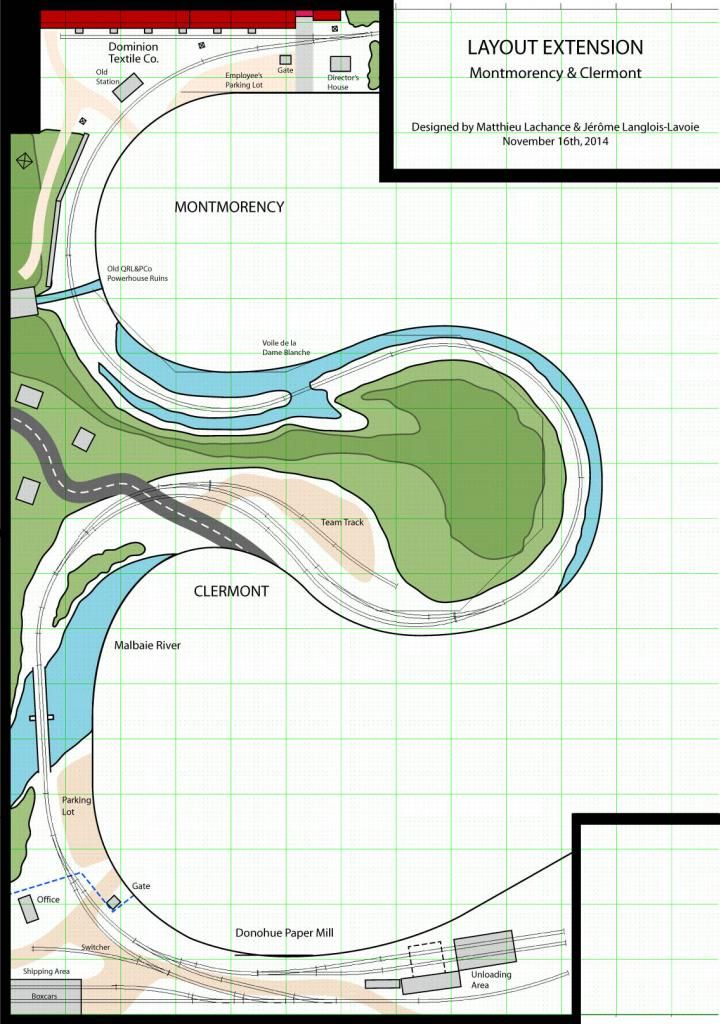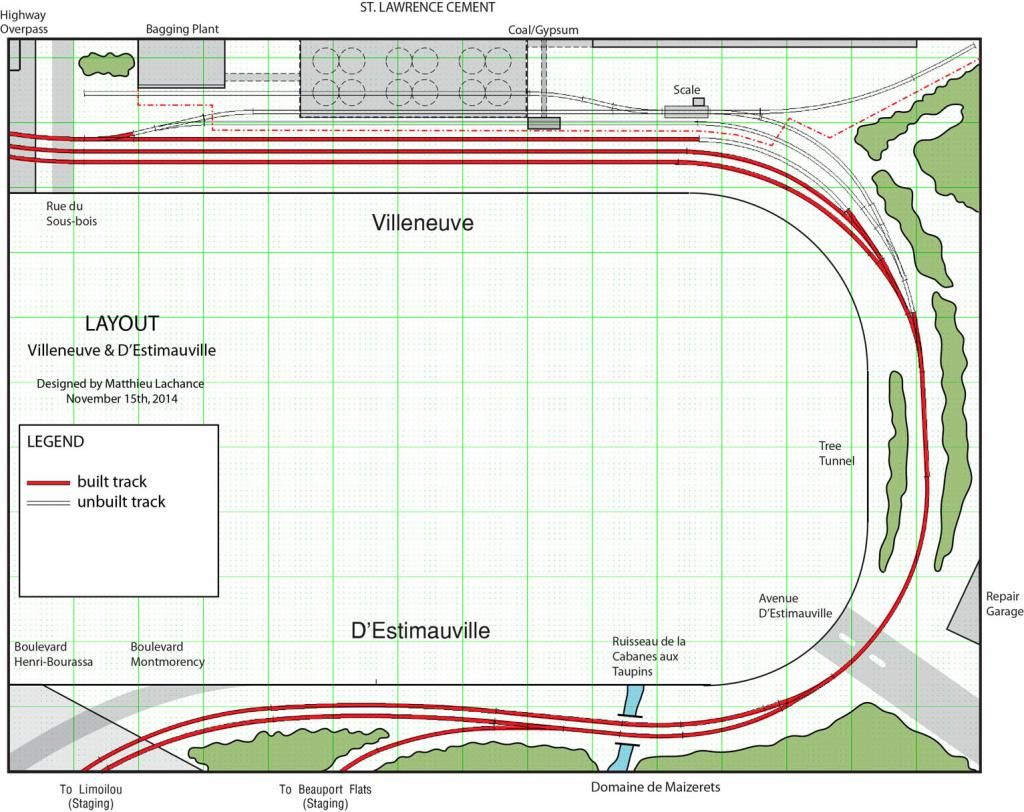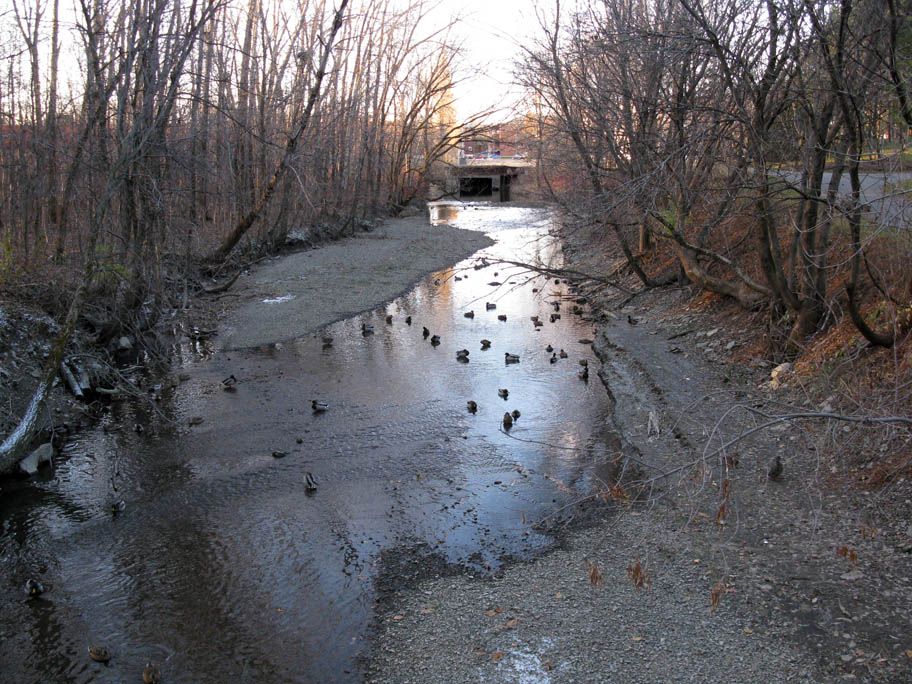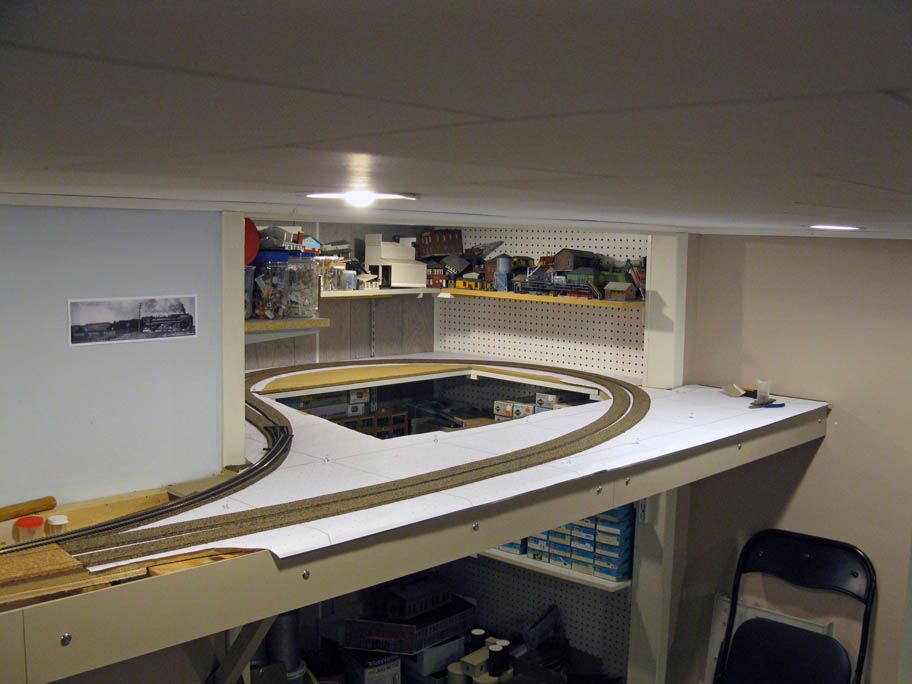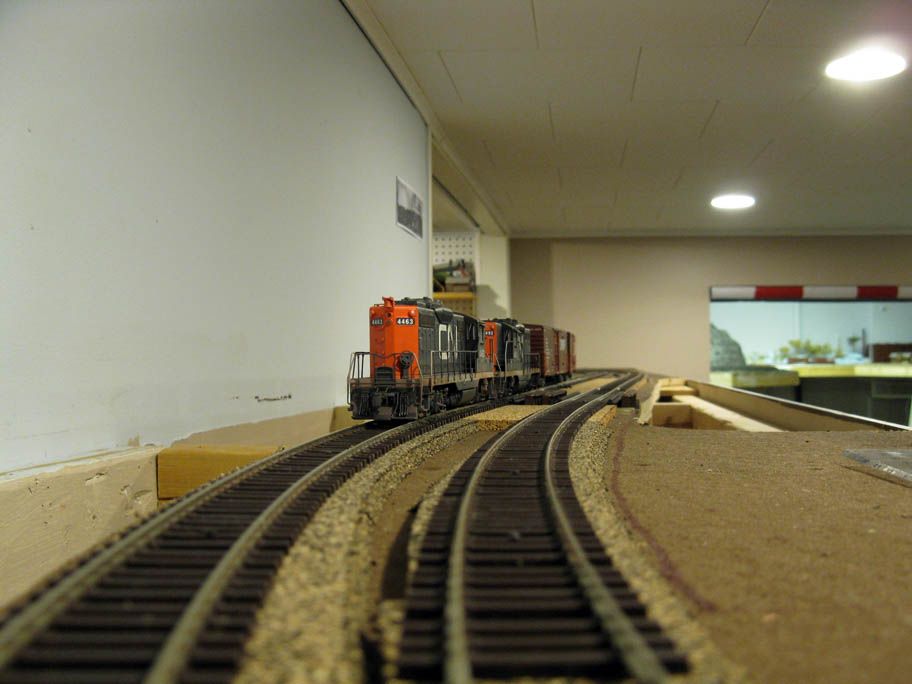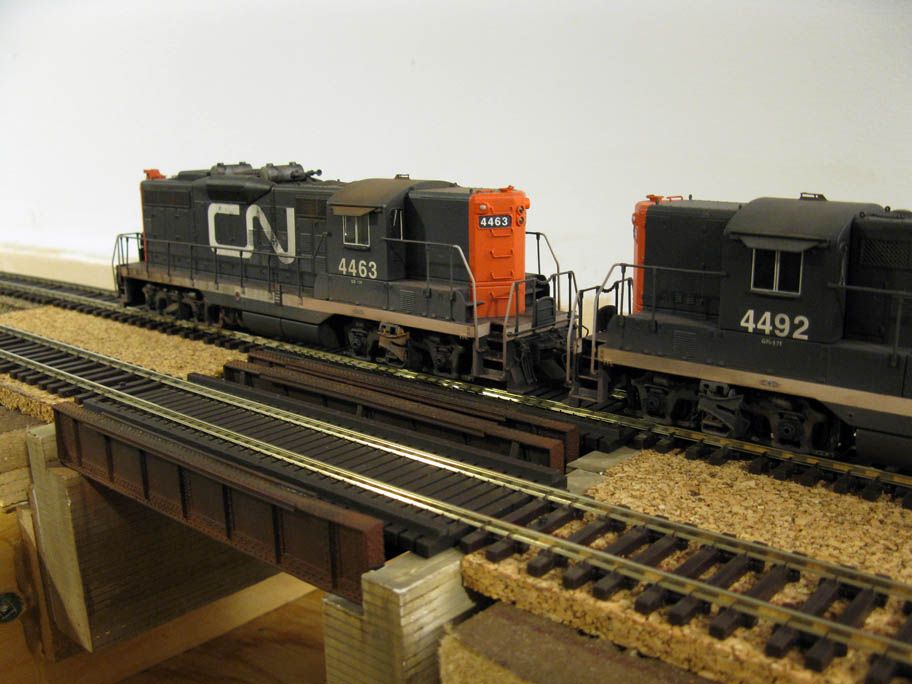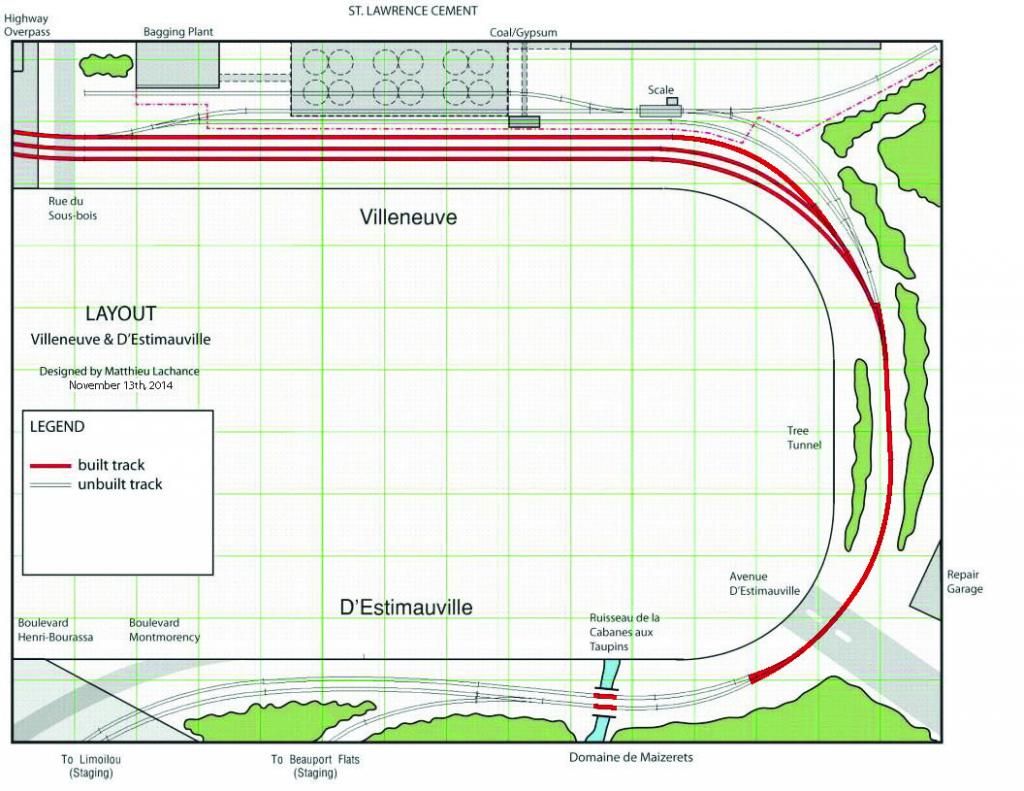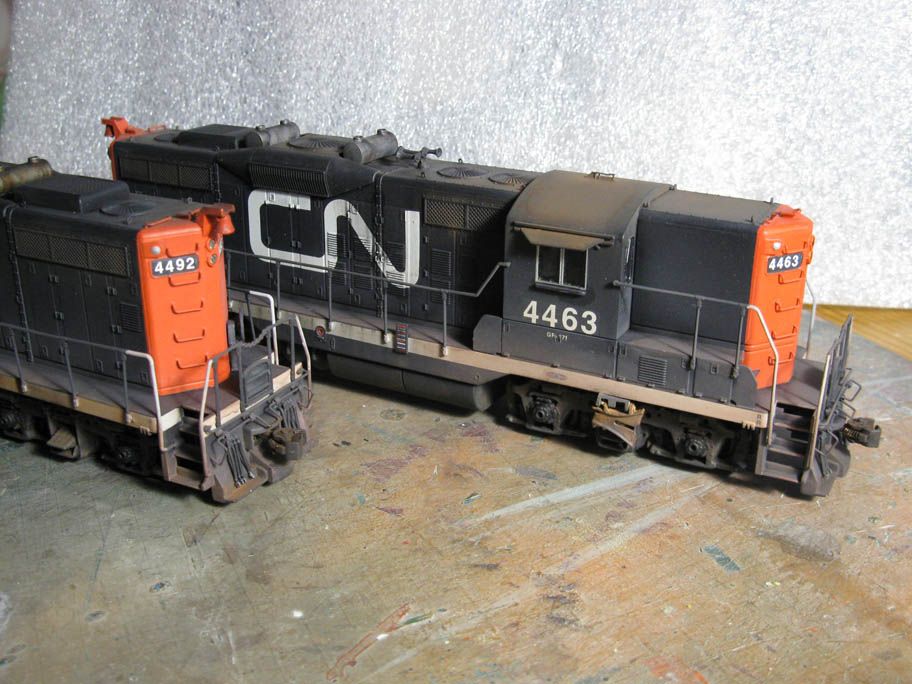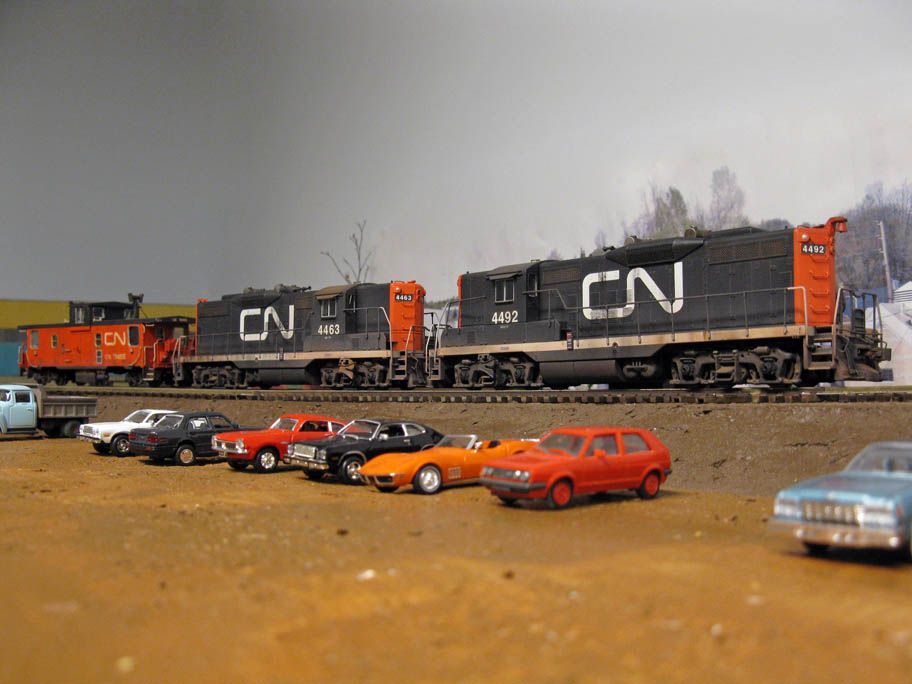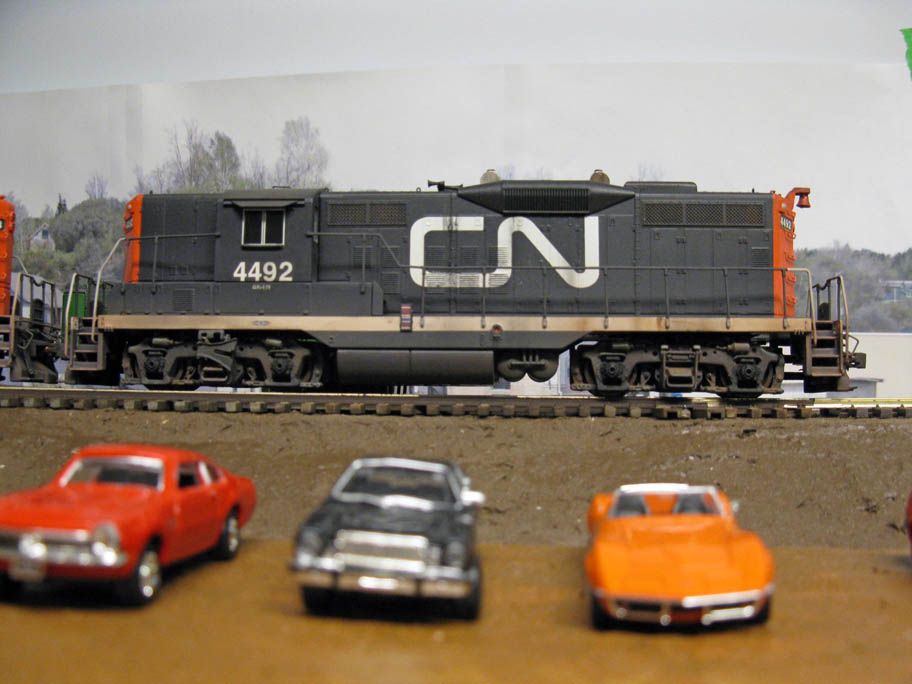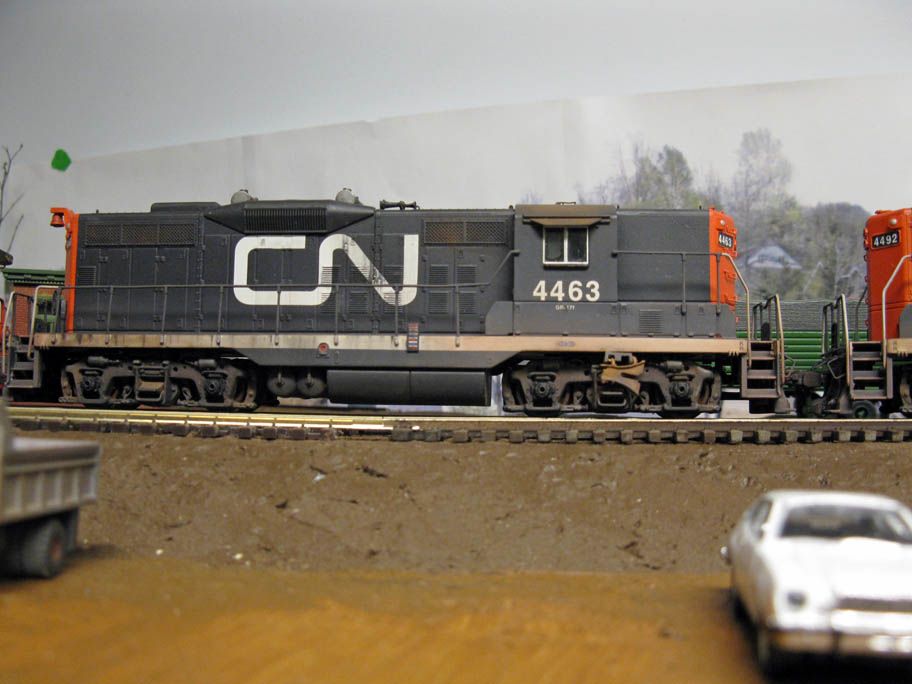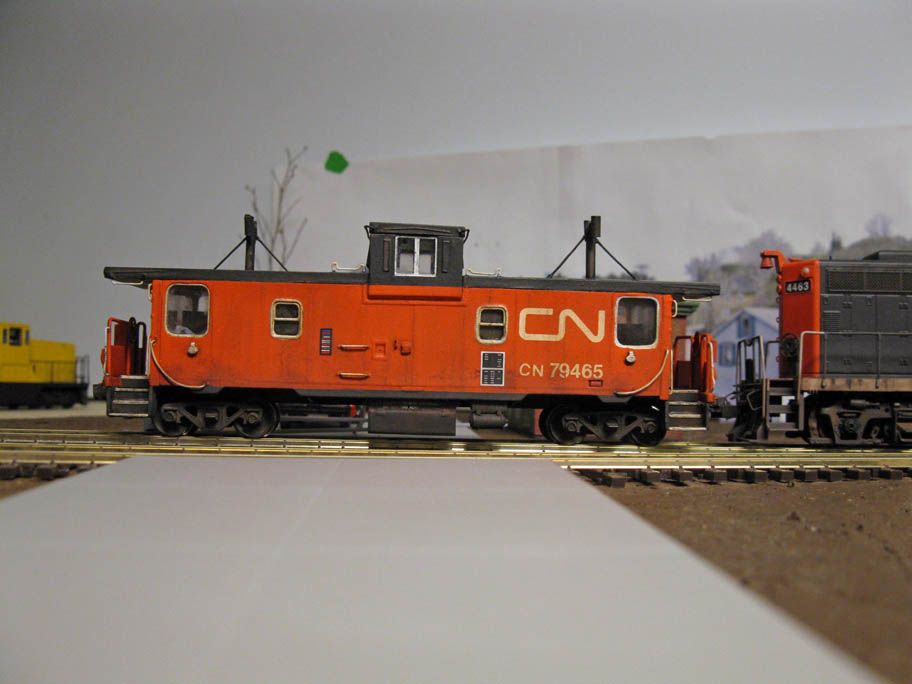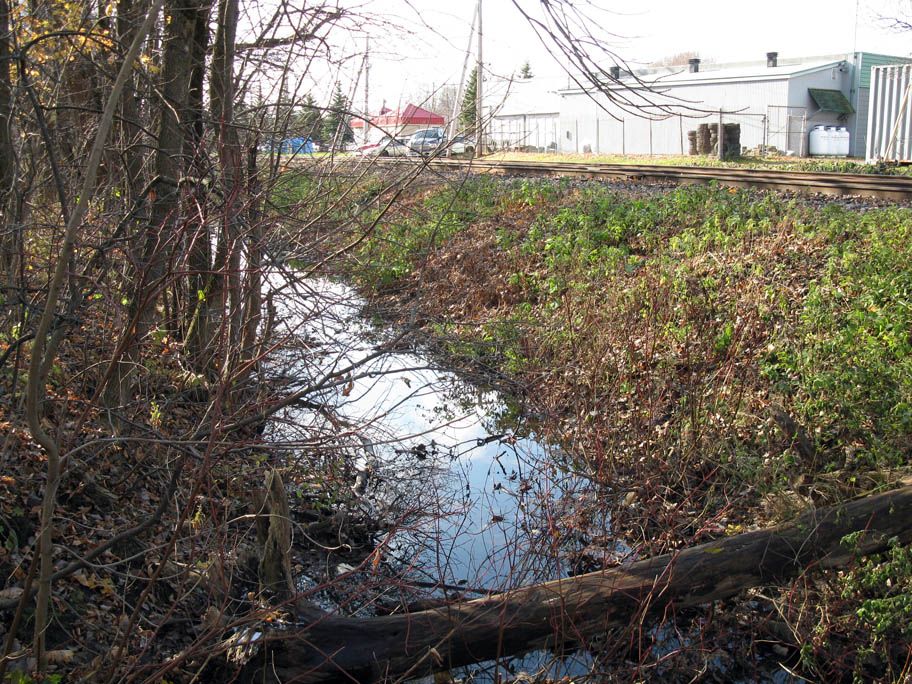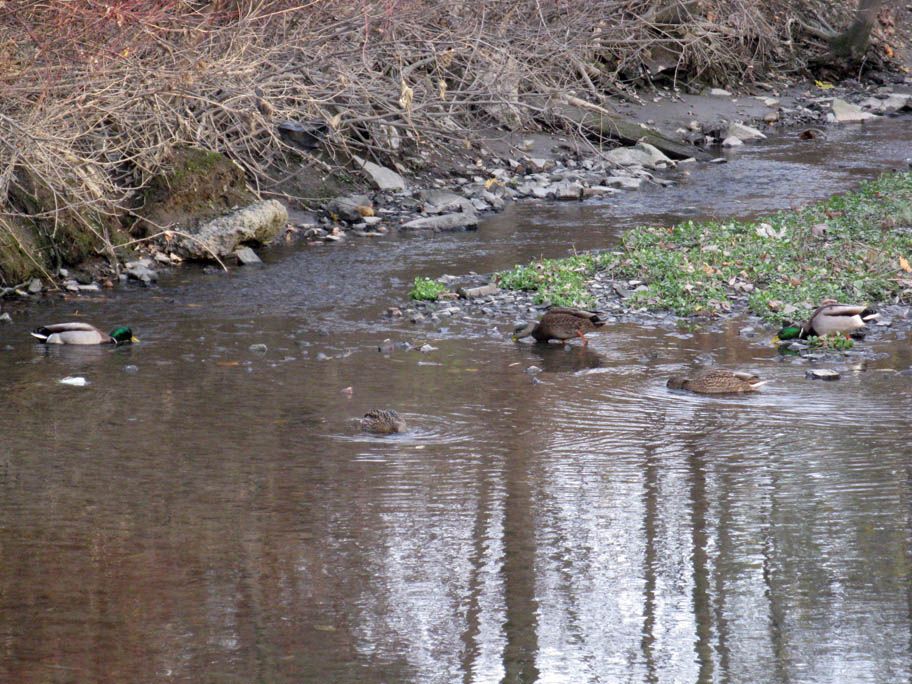Lors de l'inauguration de ce blog, j'ai eu à me poser la question fondamentale à savoir s'il serait écrit en français ou en anglais. Par soucis d'universalité, puisque l'anglais est en quelque sorte le latin des temps modernes qui permet de transcender les cultures, le choix qui s'est rapidement imposé fut la langue de Shakespeare.
Quelques francophones m'ont questionnés à ce sujet dans le passé. N'était-ce pas là un geste d'acculturation, d'autant plus étrange dans le contexte québécois? Peut-être, peut-être pas? Hier, à la radio, une jeune compositrice-interprète québécoise expliquait qu'elle souhaiterait écrire des chansons en français, mais que pour le moment, l'inspiration lui venait plus facile en anglais. Cela m'a refait penser à ma propre situation.
En effet, la technologie ferroviaire est arrivée au Québec par le truchement des Britanniques et des Américains, bien après le passage de la France. Ainsi, la plupart du vocabulaire ferroviaire a été transmis en anglais, déformé en français ou tout simplement traduit localement, indépendamment des termes utilisés dans l'ancienne mère-patrie.
En ce sens, il est donc difficile de décrire la réalité ferroviaire québécoise dans un langue française pure et qui est agréable à lire. De plus, le recours à des termes français exacts n'aurait pas toujours de résonance concrète aux oreilles du lectorat local.
J'ai souvenir enfant que nous utilisions de manière interchangeable divers mots français et anglais. La "track" était souvent préférée à "voie ferrée", mais en revanche, plusieurs mots français étaient courant. Le contact avec les railfans et les cheminots m'ont fait adopter, à mon insu, le vocabulaire anglais, beaucoup plus utilisé par les gens près du chemin de fer que par les néophytes. Ainsi, je n'utilise presque plus "wagon de queue", me contentant de "caboose", je ne parlerai même pas de "van", canadianisme qui semble être une particularité de nos concitoyens anglophones. De même, les expressions "charrue" ou encore "gratte" (dans le sens canadien de "chasse-neige") ont été remplacées par "plow" ou "snowplow". Pourtant, il serait facile de rédiger un texte en français.
Là où le bât blesse, c'est lorsqu'on plonge directement dans le vocabulaire propre au modélisme ferroviaire. On entre dans un univers assez étrange. En effet, tout québécois qui tentera de lire un livre spécialisé français risque d'avoir un choc culturel difficile à surmonter, il en va de même dans l'autre sens. Les réalités géographiques et matérielles des deux continents sont fort différentes. Rien que dans le département du matériel de bricolage, on s'y perd. Qui saura ce qu'est du "Depron" ou du "plume"? Parlez de carton à un Français, il imaginera une boîte pour déménager, pour le Québécois, ce sera naturellement la matière première et jamais il ne songera à une boîte. Même chose pour le sens de "maquette". En France, une maquette est un terme qui peut prendre un sens signifiant à peu près n'importe quoi qui est reproduit à l'échelle. Au Québec, une maquette signifie habituellement quelque chose de plus complexe qui est de la taille d'un réseau, d'un diorama ou encore d'un bâtiment, au sens architecture. Pourtant, pour un français, une maquette peut effectivement décrire une réalité comme une figurine en résine. Ainsi, pour décrire une figurine de Batman à monter soi-même, on dira une "maquette en résine". Ici, cela tomberait sous le porte-manteau du "modèle réduit en résine". Mais ce phénomène n'est pas propre à la francophonie, il est universel entre les locuteurs d'une même langue qui vivent dans des conditions différentes. Il en est de même entre les États-Unis et l'Angleterre. Quiconque fait le pas entre les deux doit s'attendre à réapprendre la moitié du vocabulaire et à sauter des unités de mesure métriques aux mesures impériales. Heureusement pour nos canadiens, aucun des deux systèmes n'a réussi à supplanter l'autre et nous sommes, pour ainsi dire, bilingues en unités de mesures, maîtrisant l'une et l'autre et n'hésitant pas à les utiliser de façon simultanée.
Mais pire encore, c'est lorsqu'on tombe dans des termes intraduisibles tels que "scratchbuilding" ou "kitbashing"! De nombreux Français ont tenté sans succès de traduire ces mots. Chaque fois, c'est un fiasco. Pourtant, le concept est simple: "construction à partir de zéro" pour le premier, et "combiner des modèles" pour obtenir quelque chose de différent de l'usage souhaité par le fabricant. Bien entendu, ce sont des concepts simples basés sur une différenciation des matériaux de base utilisés: soit on part de matériaux bruts, soit on utilise des matériaux commerciaux, préférablement des kits. Pourtant, ça ne passe pas en Français. Je veux dire par là qu'il est impossible de résumer ces concepts à un seul mot unique, comme en Anglais.
Un autre mot qui perd des plumes, c'est "weathering". Il s'agit de l'action du temps et des éléments sur un objet, sa dégradation et son défraîchissement inévitable. En français, nous avons le merveilleux terme de "patine" qui explique la même chose. Pourtant, dans l'esprit des gens, le mot patine a une connotation positive, nostalgique. On parlera de la belle patine verte du cuivre, du grisonnement du vieux bois. Bref, des évocations plutôt sympathique. Pourtant, cela manque le côté brutal du terme anglais, qui ne cherche pas à embellir mais simplement décrire. Étonnant comment deux termes pourtant identiques et équivalents ne passent pas la même charge émotive.
Finalement, un autre point est le lectorat. La plupart des gens de France qui lisent ce blog ont une affinité certaine avec le modélisme ferroviaire nord-américain, ces termes spécifiques et une maîtrise suffisante de l'anglais. Quant aux Américains et Canadiens anglais, ils forment une grande partie des lecteurs, il est donc normal de s'adresser à eux. Et puis, vous seriez surpris, mais de nombreux lecteurs sont originaires d'endroits aussi différents que la Chine, la Roumaine, l'Allemagne, l'Afrique du Sud et la Russie. Nous avons tous en commun un moyen de communication qui nous permet de transcender nos cultures et il s'agit de l'anglais actuel, celui du web, cet anglais décomplexé et dépolitisé que j'ai comparé plus tôt au latin du Moyen-Âge, ou encore au Grec de l'Antiquité.
Pour toutes ces raisons, ce blog est rédigé en français. Cela est aussi une excellente occasion de pratiquer l'usage d'un langage que je n'utilise virtuellement pas dans mon quotidien.
Néanmoins, j'avoue être le premier à déplorer que l'histoire ferroviaire du Québec est trop souvent écrite par les Canadiens anglais? Est-ce un reproche? Non, en fait, il est fascinant de ce dire que cette histoire, qui nous semble limitée, soit pourtant perçue par plusieurs de nos compatriotes comme d'une importance nationales. Cela n'est pas non plus une question d'ignorance. J'ai eu l'occasion de rencontrer de nombreux francophones qui sont de véritables encyclopédies sur pattes. Malheureusement, il semble que la notion de mettre à l'écrit et de compiler les connaissances ne soit pas très valorisées dans notre culture. Des centaines d'excellents livres potentiels disparaissent chaque année à la mort de ces mémoires vivantes. De plus, le fait de lire sa propre histoire à travers l’œil d'un anglophone ne nous présente que la moitié de l'histoire. Souvent celles des promoteurs de ces lignes et de politiciens influents, mais rarement du point de vue des gouvernements locaux, des constructeurs et de l'impact réel dans l'évolution du territoire local. Pourtant, c'est là l'aspect le plus concret de l'histoire ferroviaire, celui qui permet d'en tirer des leçons. Dans le meilleur des mondes, l'histoire des chemins de fer au Québec devrait nécessairement être écrite par des concitoyens des deux langues afin d'avoir un portrait global qui va de l'intérêt local jusqu'aux visées internationales de ces entreprises tentaculaires.
Sur ce, je remercie tous les lecteurs francophones de ce blog et je prend la peine de dire que je ne les ai pas oublié. D'ailleurs, ils remarqueront que depuis quelques semaines, j'ai cessé de traduire les noms d'entreprises ou de localités français lorsque je décris le réseau.
Saturday, November 29, 2014
Tuesday, November 25, 2014
Delving Into Archives
Last Friday, I visited Bibliothèque and
Archives nationales du Québec (BAnQ) located on University Laval campus.
Browsing through their web-based database, I found out they had an interesting
photo-report of Ciment St-Laurent plant in Villeneuve dating back to 1958. So,
I decided to pay them a visit after work.
Unfortunately, there was no photo in the
archives, only negatives. But it was better than nothing and equipped with a
light table, I could have a glance at them. In fact, the inverted black &
white shades gave them a surrealistic look and a genuine artistic value. The
plant – as originally built – is truly an industrial architecture gem. No
wonder the photo-report was commissioned by Inventaire des Oeuvres d’Arts du
Québec, a now defunct government entity that recorded past and present cultural
artefacts in Quebec. Such an inventory still exists in the United States.
Unfortunately, Canada and Quebec in particular are always quick to dismiss
their own history and identity. I won’t turn that into a political feud – which
I always find unproductive – however, there’s always something disturbing about
people unable to face themselves in the mirror. It always makes me smile when I
hear intellectuals say we are a “new” country with little history, almost a
blank sheet of paper you can write everything you want… Well, get real, it’s
been over 400 years now and there’s more laying under the surface than one
could think of!
That said, information gathered from the
negatives is impressive. First of all, the property wasn’t fenced at all back
then which made the impression Villeneuve was a 7-track yard (there was no
delimitation between private and QRL&PCo tracks). Many types of cars could
be seen under the silos, including 40ft OSB wood boxcars, 40ft steel boxcars,
slabside hoppers and braced covered hoppers from early CN experimentation with
this type of cars. About half cars were boxcars, which is quite impressive but
not surprising for that era.
Other pictures shown glimmering rails under
overhead wires with silos silhouettes in the background. A nice shot was taken
from the back of the plant. Bulk cement semi-trailer trucks were emerging from
the silos substructure while railcars were shoved in the background.
Interesting pictures included also close up views of conveyor, coal storage
area, overhead crane and track scale.
I was particularly impressed with the offices
and machine shop buildings. I knew them in their last years, but they indeed
were very interesting modern piece of architecture with very slick lines,
generous glazing and clean siding materials. I’m not a fan of this
architectural era, but I must admit you could sense some thoughts were given
when designing them. Unfortunately, industrial pollution, dust and cement
particles quickly covered them and we only remember them as grayish dusty boxes
with faded green trims. Later modifications wiped out any remaining
architectural interest they had retained.
BAnQ staff was kind enough to offer me to scan
the pictures, but at 20$ per scan, it would have been quickly prohibitive since
about 20 pictures were worth reproduction. Also, when I explained I was working
on a scale model of the plant, they told me if I worked with their pictures, I
would need a licensing agreement to show the model in public or publish work
about it. I find that claim quite dubious since it means most people detailing
cars from archives couldn’t publish their work without such licensing. It makes
no sense to me, since the model would be mainly designed from other source
material like Insurance Maps, Google Earth, Bing Maps, personal pictures and
from other people. Anyway, I preferred to not venture in that mined field!
When leaving BAnQ, it was clear that modelling
the offices and machine shops would be a must on the layout. Fortunately, Bing
maps have recorded these building just before they were slated for demolition a
few years ago. It’s more than enough to make a decent model of them.
Now, the real issue is finding a way to get a
decent picture of the kiln building in the background. Most pictures of it are
low resolution and heavily slanted. Even in Photoshop, there’s little to do
about them. And if you talk about the
kiln, you also need to put in the large kiln stack that towered at 450 feet. My
grandfather built the foundation forms of that stack back in the mid-50s. I
remember he told us he was a little bit sad it was destroyed after only 50
years. He was told, back then, it would last for a least a century. It was his
first important jobs when he moved from Charlevoix to Quebec City. So, for now,
my best bet is to find a similar industry and photoshop it into something
similar to my prototype.
Sunday, November 23, 2014
Completed mainline
Mainline is back in service. The last stretches of flextrack were laid yesterday, completing the staging. Also, Ciment St-Laurent trackage is now starting to take shape and the unloading pit for coal and gypsum is now in place. So far, only 28 feet of tracks need to be laid and this part of the layout will be completed.
It's been a real long time since the entire layout was functional and it's great!
Also, you remember my posts about equated tonnage rating for locomotive and adding weight to freight cars? We moved some trains yesterday and it became extremely clear a train would stall if you didn't add the suitable motive power. You could really sense the locomotives were trying to move heavy railcars, making everything more realistic. Also, if you were able to move a long train with one engine in Villeneuve, it didn't mean it would be enough to handle the serious curves in Murray Bay. Once again, physic laws were well scaled down by adding weight in cars.
It was also evident the small Bachmann GE 45-ton will be a little bit weight in the cabs to be able to put a typical 6 cement cars consist.
Moving trains over Hedley-Junction layout is now longer a matter of playing with toys but rather a matter of moving freight cars with optimal efficiency.
Sorry, no picture this week, I forgot my camera at home...
It's been a real long time since the entire layout was functional and it's great!
Also, you remember my posts about equated tonnage rating for locomotive and adding weight to freight cars? We moved some trains yesterday and it became extremely clear a train would stall if you didn't add the suitable motive power. You could really sense the locomotives were trying to move heavy railcars, making everything more realistic. Also, if you were able to move a long train with one engine in Villeneuve, it didn't mean it would be enough to handle the serious curves in Murray Bay. Once again, physic laws were well scaled down by adding weight in cars.
It was also evident the small Bachmann GE 45-ton will be a little bit weight in the cabs to be able to put a typical 6 cement cars consist.
Moving trains over Hedley-Junction layout is now longer a matter of playing with toys but rather a matter of moving freight cars with optimal efficiency.
Sorry, no picture this week, I forgot my camera at home...
Tuesday, November 18, 2014
Surprise! CN 6206
Well, Jérôme decided to invest in rolling stock, a thing he rarely does: a CN P1K RDC-2 Budd car.
Strange? No! RDC-2 ran on Murray Bay sub during the 70s until 1976 when passenger service was discontinued. Better, the P1K unit roadnumber - 6206 - is the same I've seen on actual pictures taken in Clermont by Denis Fortier. Mr. Fortier was kind enough to provide me some scans of old pictures to confirm the fact.
Are we planning to run passenger trains. Not really. To be honest, our layout's sharp curves makes passenger cars toyish, very toyish and they don't like the peninsula. A RDC-2 can manage those sharp curves easily.
But Jérôme wants to equip the Budd car with a camera and a WiFi system. Don't ask me detail, I'm still living in a pre-cellphone world! I think this is a neat idea and will probably put wrote other posts if the project take shape.
By the way, I'm actually working on the photo backdrop for d'Estimauville and Villeneuve. So far, about 33% of the project is done. This is truly time consuming but worth the effort, and the fact I caught poison ivy while taking pictures of Maizerets. I once caught it when I was a teenager and quickly recognized the symptoms in the first minutes. Drastic measures were taken and infection was kept to minimum and they quickly recessed. What a relief! That plant knows how to make your life miserable!
Anyway, making the cement plant backdrop is gonna be a real challenge. If the building was still standing, it would be a piece of cake. But it is now gone and good pictures of it are scarce.
Strange? No! RDC-2 ran on Murray Bay sub during the 70s until 1976 when passenger service was discontinued. Better, the P1K unit roadnumber - 6206 - is the same I've seen on actual pictures taken in Clermont by Denis Fortier. Mr. Fortier was kind enough to provide me some scans of old pictures to confirm the fact.
Are we planning to run passenger trains. Not really. To be honest, our layout's sharp curves makes passenger cars toyish, very toyish and they don't like the peninsula. A RDC-2 can manage those sharp curves easily.
But Jérôme wants to equip the Budd car with a camera and a WiFi system. Don't ask me detail, I'm still living in a pre-cellphone world! I think this is a neat idea and will probably put wrote other posts if the project take shape.
By the way, I'm actually working on the photo backdrop for d'Estimauville and Villeneuve. So far, about 33% of the project is done. This is truly time consuming but worth the effort, and the fact I caught poison ivy while taking pictures of Maizerets. I once caught it when I was a teenager and quickly recognized the symptoms in the first minutes. Drastic measures were taken and infection was kept to minimum and they quickly recessed. What a relief! That plant knows how to make your life miserable!
Anyway, making the cement plant backdrop is gonna be a real challenge. If the building was still standing, it would be a piece of cake. But it is now gone and good pictures of it are scarce.
Sunday, November 16, 2014
Peninsula - Setting Better Standards
If our almost 8 years building this layout told us, it's that you always set wrong and diminutive standards when you start off your project. Over optimistic goals quickly plague your design and operation has you tried to get the most out of anything by using the smallest standard available.
I know, I've been there and done that for decade. Space was always at premium and the logical reflex was to cram everything at any cost. Since this spring, I've tried to fought back this ridiculous train of thoughts by streamlining my goals to the essential. Doing so helped me to find out I had much more space than I assumed, thus enabling me to move toward better standards.
Yesterday night - or should I say morning since it was 2 AM - Jérôme talked about how the layout was now much more mature than it never was in the past. Discussing about the peninsula, we were recognizing its building standards were subpar. The track radius, which is something like 22 inches is starting to be a problem. This part of the layout is really capricious and 6-axle locmotives like GMD1 have a hard time to run there. Forgot any passenger equipment, it is plain ridiculous. Also, the very thight radius induce a lot of stress in long freight consists.
Anyway, we will have to partially rebuild the peninsula when Clermont station will be built. I think we should take this occasion to buff up the standards. That means larger radius curves. I consider 30 inches to be a minimum. If I could, I would go for 42 inches, but doing so would make the aisle impractical and I don't think Louis-Marie would accept that!
That said, upgrading the track there has a positive effect. It adds a few feet to main line length in such a way that Clermont scene won't contaminate Montmorency. That was the case in the previous version, but now the run along the river shore is longer, giving the feeling the train is travelling a few extra miles in remote area.
Nothing is cast in stone, but I feel some serious thoughts should be given to address this future issue. At this point, priority is on D'Estimauville and Villeneuve, but rebuilding Clermont and removing remaining code 100 track on the peninsula and Montmorency could be the biggest challenge in 2015.
I know, I've been there and done that for decade. Space was always at premium and the logical reflex was to cram everything at any cost. Since this spring, I've tried to fought back this ridiculous train of thoughts by streamlining my goals to the essential. Doing so helped me to find out I had much more space than I assumed, thus enabling me to move toward better standards.
Yesterday night - or should I say morning since it was 2 AM - Jérôme talked about how the layout was now much more mature than it never was in the past. Discussing about the peninsula, we were recognizing its building standards were subpar. The track radius, which is something like 22 inches is starting to be a problem. This part of the layout is really capricious and 6-axle locmotives like GMD1 have a hard time to run there. Forgot any passenger equipment, it is plain ridiculous. Also, the very thight radius induce a lot of stress in long freight consists.
Anyway, we will have to partially rebuild the peninsula when Clermont station will be built. I think we should take this occasion to buff up the standards. That means larger radius curves. I consider 30 inches to be a minimum. If I could, I would go for 42 inches, but doing so would make the aisle impractical and I don't think Louis-Marie would accept that!
That said, upgrading the track there has a positive effect. It adds a few feet to main line length in such a way that Clermont scene won't contaminate Montmorency. That was the case in the previous version, but now the run along the river shore is longer, giving the feeling the train is travelling a few extra miles in remote area.
Nothing is cast in stone, but I feel some serious thoughts should be given to address this future issue. At this point, priority is on D'Estimauville and Villeneuve, but rebuilding Clermont and removing remaining code 100 track on the peninsula and Montmorency could be the biggest challenge in 2015.
D'Estimauville: Toward Completion
Yesterday was a very productive day. We can say about 60% of track have been laid in Quebec City Area. Only some tracks in staging remaing to be spiked and the cement plant. In fact, we lacked track and a new order was placed today.
In the afternoon, we went back to Maizerets to get more dried weeds. They will be needed to forest Domain Maizerets later. Once again, the place was infested with ducks. We counted more than a hundred of them near the railway bridge. At some point, they climbed the river bank and followed a youg kid they probably thought had food.
Back home, we started to lay track in the staging. Last week, it was evident trying to get smooth flowing transition curves would be quite a challenge. Jérôme suggested we print the track plan full scale and pin it on the benchwork.
Cork strips were nailed down over the track plan. XtrackCAD have an option to indicate centerline, which was useful to pin down the cork. This job was over quickly. Using an hobby knife, we trimmed the excess paper.
Finally, laying track ended up being almost a child play.
Very large and smooth curves were obtain. This gives a much more realistic look the track work and it is more prototypical to Maizerets, which is nothing but a very broad curved pair of parallel tracks.
The smaller visible radius is now 30 inches over a very short stretch that lead to Beauport Flats.
We've got some alignement problem at the railway bridge. It seems it wasn't installed correctly and track will need to be shimmed. Nothing to be seriously concerned and it is barely noticeable.
Finally, Louis-Marie came out with a neat idea to add devices to the fascia without altering it. I find it much more elegant and less likely to be a future liability.
During our proverbial railfanning at the end of any building session, we followed train 524 pulling empty cement hoppers en route to Villeneuve.
In the afternoon, we went back to Maizerets to get more dried weeds. They will be needed to forest Domain Maizerets later. Once again, the place was infested with ducks. We counted more than a hundred of them near the railway bridge. At some point, they climbed the river bank and followed a youg kid they probably thought had food.
Back home, we started to lay track in the staging. Last week, it was evident trying to get smooth flowing transition curves would be quite a challenge. Jérôme suggested we print the track plan full scale and pin it on the benchwork.
Cork strips were nailed down over the track plan. XtrackCAD have an option to indicate centerline, which was useful to pin down the cork. This job was over quickly. Using an hobby knife, we trimmed the excess paper.
Finally, laying track ended up being almost a child play.
Very large and smooth curves were obtain. This gives a much more realistic look the track work and it is more prototypical to Maizerets, which is nothing but a very broad curved pair of parallel tracks.
The smaller visible radius is now 30 inches over a very short stretch that lead to Beauport Flats.
We've got some alignement problem at the railway bridge. It seems it wasn't installed correctly and track will need to be shimmed. Nothing to be seriously concerned and it is barely noticeable.
Finally, Louis-Marie came out with a neat idea to add devices to the fascia without altering it. I find it much more elegant and less likely to be a future liability.
During our proverbial railfanning at the end of any building session, we followed train 524 pulling empty cement hoppers en route to Villeneuve.
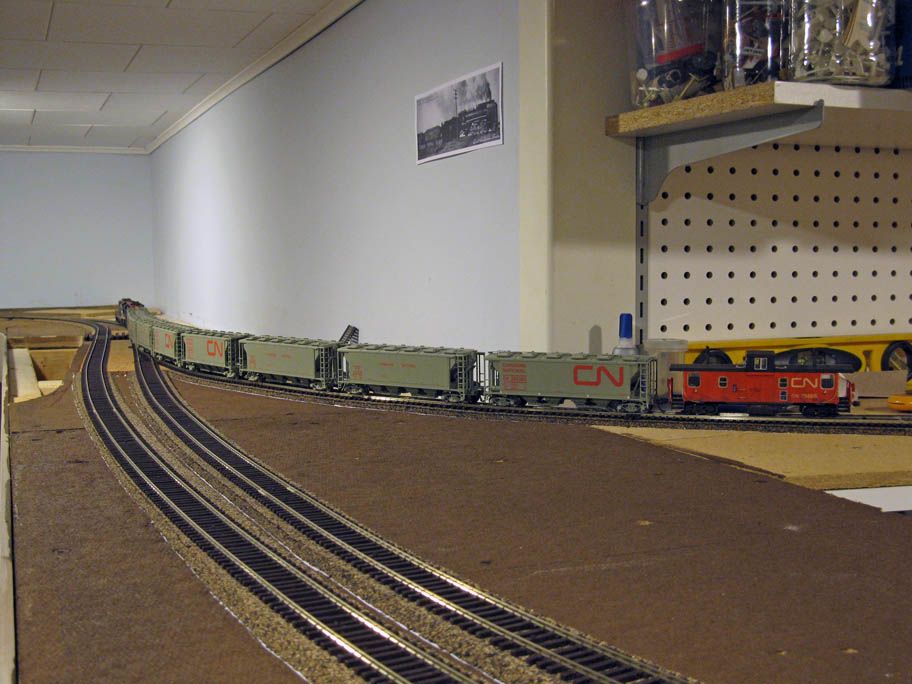 |
| 524 leaving Beauport Flats |
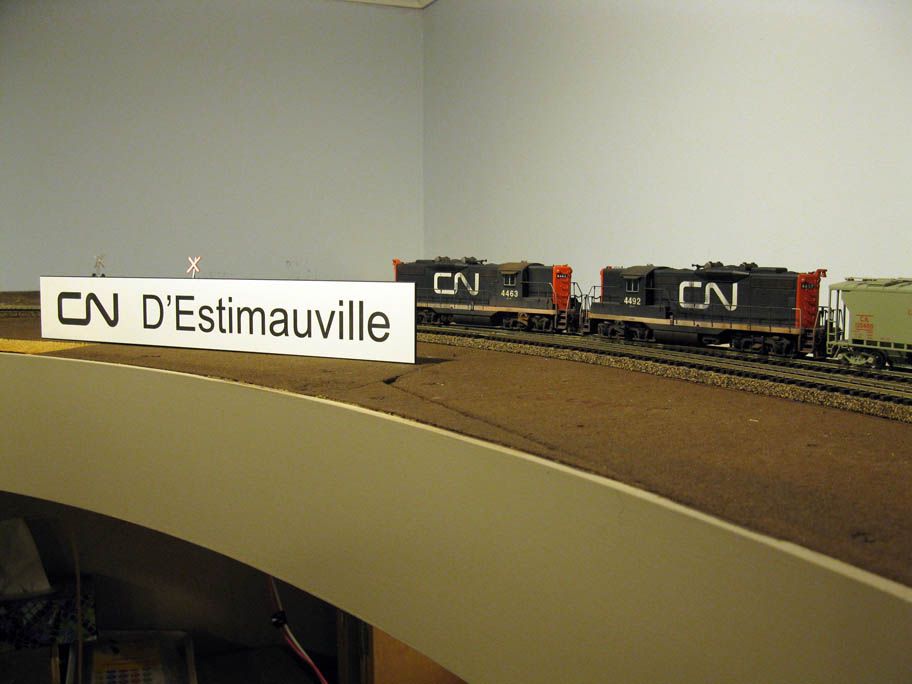 |
| 524 reaching D'Estimauville Avenue |
 |
| Stand in crossing signals at D'Estimaville |
Friday, November 14, 2014
Bridge Over Rivière de la Cabane au Taupier
We did some
significant progress yesterday. Bridges over Rivière de la Cabane au Taupier
were installed to span the last obstacle on the layout. Now track laying can be
done without any further benchwork modifications. That’s a great relief! The
update plan shows in red what has been done during the last month. The next
step is to build the staging and then, Ciment St-Laurent will be the last part
to be done before Christmas, if possible.
About the
river’s name…. Well, it’s complicated. This small brook sported many names over
the time and over different geographical areas.
Just to
list a few of them: Cabane au Taupier, then Ruisseau La Taupière, Les
Taupières, de la Cabane aux Taupières, aux Taupinières, Mastaï (from the nearby
asylum) and du Moulin (lots of mills were powered by this river). Out of
Beauport area, two names were used: Rivière des Commissaires (Commissaries’
River) in Charlesbourg and rivière Chalifour in Maizerets Domain (the exact
location we are modelling).
A “Taupier”
is a man whom profession is to eradicate moles. A “Taupinière” is a mole nest.
A “Cabane” is a small hut. When you piece things together, it became clear
that during the early settlement of the area, a man was hired by local
landloard to exterminate moles in the area and a dedicated building to house
him stood by the river. With time, the name was corrupt and original meaning
lost. Maizerets, then called Canardière was always a large rented piece of
agricultural land that served landlords and later Seminary of Quebec. It makes
senses that they hired someone to control vermin in the nearby wetlands.
 |
| Maizerets in 1960, railway on lower right, highway on upper left (credits: QQIBC) |
To stay
true with history, from now, the brook with be called on this blog “Rivière de
la Cabane au Taupier” that I would translate roughly in Mole Catcher’s Hut
River which is a colourful name. Mill’s brook and other generic names have no
appeal and hardly represent the fact the railway is crossing a wetland
inhabited by hundreds of ducks and moles. It is also the name that could be
found on Fire Insurances Maps from the 50s.
Model
railroading is something very “North American”. Scenery and names can really
help to locate it in this particular Quebec City area well-known for its
ancient French heritage. I guess most English-speaking readers won’t mind we
use “Rivière” instead of “River”. They are basically the same word with almost
the same pronunciation.
Thursday, November 13, 2014
Completed Bachmann CN GP9s
Last week end, I completed detailing and painting my pair of CN GP9. Small details, but mainly weathering had to be done before putting the models back on track.
Weathering was done according to prototype pictures from cnrphotos.com website. I tried to reproduce a relatively dirty and faded early 80s look. I didn't want rust buckets!
As always, the end result is a combination of many technics, including thinned acrylic washes to fade the paint, oil painting streaking effects and pastel chalk.
On the trucks, I tried something new to reproduce oily axle bearings. I brushed full-strength black oil paint on the bearing then dabbed black pastel chalk and let it dry. The effect is just like the real thing: a mix of greasy and dirty oil. I've seen too many people trying to achieve this look with glossy paint and feel it's not true to the real thing.
Unfortunately for us, when we tested the locomotives on the layout that evening, we found out electrical pickups were inefficient and plagued the model. The guy who installed the sound decoders had told us about it. Seems he was right and this will have to be addressed before they can be used.
When looking back, I'm not sure bashing those 2 locomotives was a deal, even if I bought them at cheap price. If you add brass detail parts, paint, decals, sound decoders, other bits and shipping, the total cost really piles up and the locomotive is just another stand in with lots of discrepancies. Worst, meanwhile Athearn announced a prototypically correct canadian GP9. If I had made a few more modifications to get the model right (correct stanchions, etc.), the end price could have been higher than a brand new Athearn with sound at full MRSP. So no, we may think we can get an "economic alternative" by adding a few details and better decoders, but it isn't. If you are not looking for prototypicalness or sound, that's fine, but if you want more realistic stuff save your bucks and wait.
In the end, I have no regrets, when I started the project, no canadian GP9 was available. Also, I bought those locomotives for a previous iteration of the layout. It would have been a waste to not use them to further improve my skills. I learned a lot in the process and must say I'm better than when I started. Also, I prefer to have upgraded a Bachmann GP9 than an old Athearn BB kit which is just plain wrong (I know, I did in the past). Details are still good for the price and it works fine. They should do the job until I can get my hand on M420 some day. It's just sad the amazing Rapido GMD1 are actually becoming the starsr on the layout. I'm not sure my pair of GP9 will have any chance to shine against such beautiful models. I can only hope Rapido will give serious thoughts about making a M420. No offence intended to American manufacturers, but I feel only a canadian company can do justice to this great prototype. I've been too much disappointed by recent wide cab releases... except Athearn that seems to have got things quite right...
That said, while my weathering work was drying, I also decided to rebuild my Pointe Saint-Charles caboose. It is an old Sylvan scale model I bought back in 2000 or 2001 with a long lost good friend. it was my first ever resin kit and I made a lot of mistakes when building it. As expected, it badly warped and I never completed it until a few years ago. I did my best during the second rebuild but didn't address the warping issue and weight wasn't enough to keep the caboose on track. A year ago, it broke in pieces during operation.
So, I decided to remove the weights and ill-conceived structural members. I remplaced them with a large 1/4" MDF beam painted in black and some styrene strips to straight up the underframe. Then I added lead wheel weights. CA fog on windows was cleaned with acetone and a coat of Future floor finish applied to bring back some cleanliness to the plastic material. I wasn't miraculous, but it made the model more acceptable and got rid or annoying fingerprints!
I didn't repainted the model, but added ACI labels and consolidated lube stencils. I also improved the weathering a little bit. This model won't win me a prize, but at least can do the job waiting for something better.
Wednesday, November 12, 2014
Backdrops, Ditches & Ducks
Yesterday, I
took some time off in the morning to shoot a few more pictures for the future photo
backdrop in Maizerets. My first try Saturday was an utter failure and the end
result hardly satisfying. Instead of trying to shoot the railway side of Domain
Maizerets, I decided to make a backdrop out of the highway side. A large strip
of public land is accessible between the highway and CN Beauport Flats yard.
From this vantage point, the line tree is regular, the scene well-lighted and you can take pictures from the same distance over many hundred feet.
 |
| Quebec City seen from Maizerets crossing in D'Estimauville |
After this
session, I went to Maizerets Observatory – an observation point with a great
panorama of Quebec City – to make more generic backdrop of Beauport for the
cement plant. It was also a good spot to make a backdrop of Quebec City skyline
without too much tree and utility poles interference. This view of Upper Town
is a staple of D’Estimauville. From the track at Maizerets, you can see the
skyscrapers emerging in the distant horizon. I feel it is a necessity to have
this view on the layout. It makes a clear statement that trains originate from
this point and set the mood. I’m quite lucky because Quebec City’s skyline
didn’t change since the last skyscrapers were built in the mid-70s. A
moratorium was put in effect back then to stop the urban massacre.
On a side
note, I strolled through Maizerets Domain to get ideas for scenery. Late autumn
and early spring are quite similar, so I guess many things I saw are fitting in
our early spring setting.
Two main
things became fully apparent to me. First, the land surrounding the railway is
clearly lower than the roadbed, about 5 feet. Also, large and deep ditches are
found on both sides, often with large ponds.
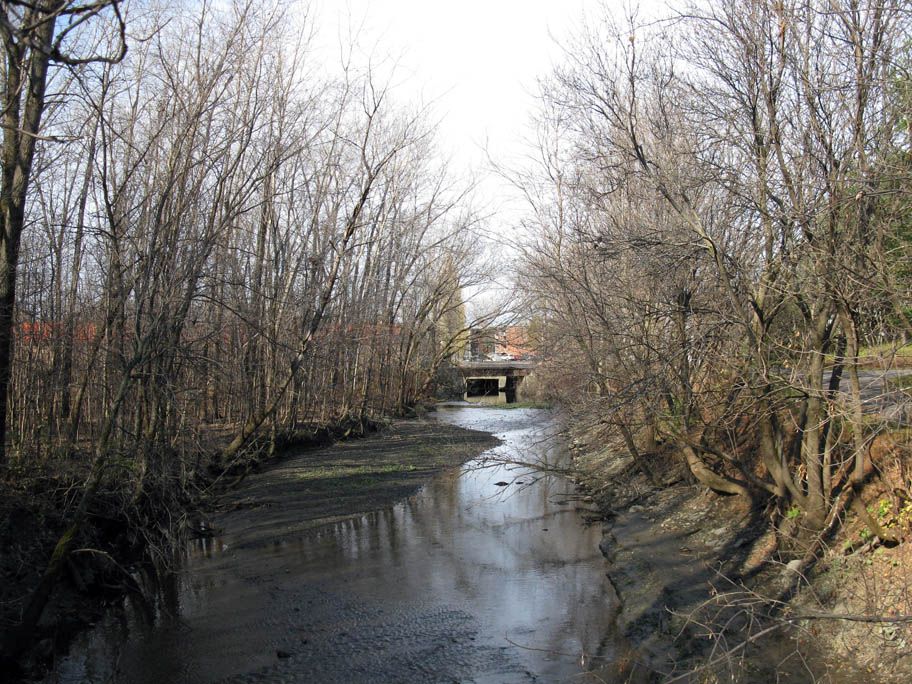 |
| Rivière de la Cabane aux Taupiers and railway bridge in the background |
Second,
mallard ducks are everywhere. D’Estimauville and Maizerets are parts of a
general area that was known as La Canardière (the place where ducks gather)
since the late 17th century. Seriously, they rule the place. Saturday, I could shoot a few of them eating near the railway bridge.
But yesterday, I could
see about 80 of them in a very small pond. I often talked here about this small brook scene and also kitbashed
bridges, but I must say the scene won’t be complete without a big flock of
ducks under it.
All these
discoveries mean we have to modify the benchwork a lot to have a realistic
topography for this scene. Last Saturday, we removed most of the plywood
support and only kept the roadbed. This is the price to pay to have the ditches
and the brook. It was also a good lesson. Our benchwork building method using
2” X 3” lumber and 1/4” plywood with 1/2” fiberboard is primitive and not
sturdy enough for serious scenery. So far, we managed to do something decent,
but I’ll never build a layout using this method. Benchwork is prone to sagging
and warping and not very forgiving when scenery must sink below roadbed.
 |
| Modified benchwork in D'Estimauville |
We will
live with it and add structural members as required to make things last.
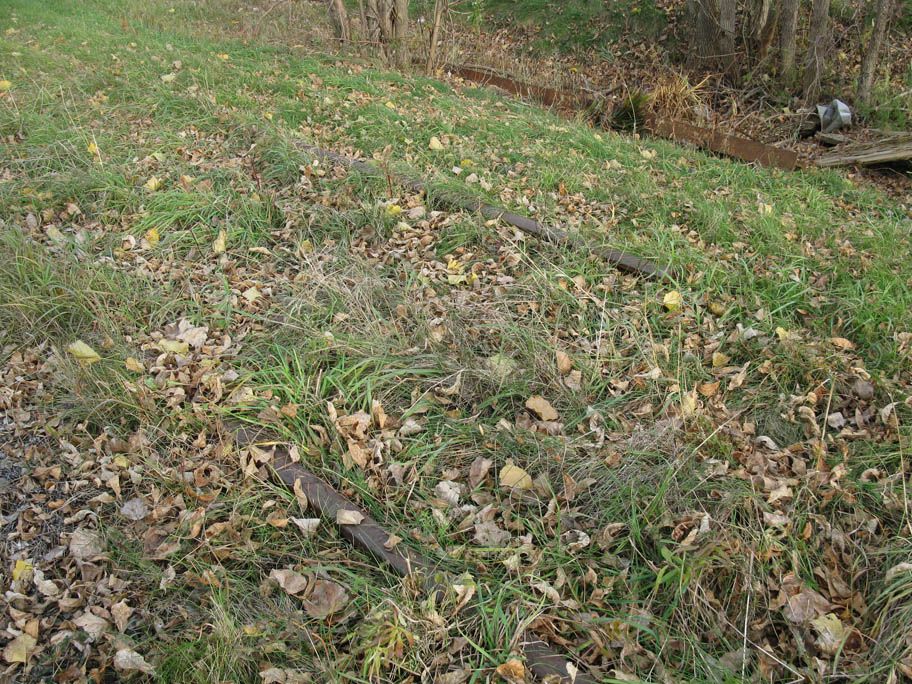 |
| Old 85 lbs rail on former QRL&PCo double main line in Villeneuve, QC |
By the way, I also had a glance at former Quebec Railway Light & Power double main line in Villeneuve. I was under the impression it was pulled out a few years ago when then updated the track, but seems it is still there over a mile. QRL&PCo used to be a busy interurban line and between Quebec City and Montmorency, the line was double tracked to handle the heavy passenger traffic. Rails found Saturday were all 85 lbs and were put in place circa 1900-1910. No wonder Murray Bay Subdivision was under weight restriction until the late 70s and early 80s when track was upgraded. Thanks to these small rails, the line was graced with GMD1 and RSC24, a one of kind prototype built in the early 1960s for this very subdivision.
Subscribe to:
Posts (Atom)


